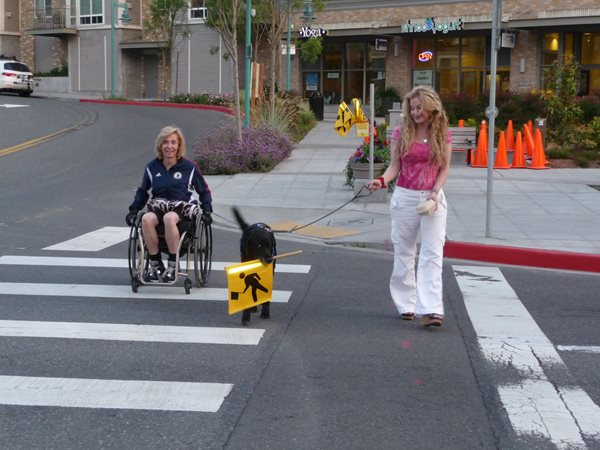Creating Complete Streets
Movement aims to make roadways safer

In many ways, it is easier to describe what a complete street isn’t than what it is. A non-complete street primarily serves the through-put of automobiles. If pedestrians, bicyclists, transit riders, and diners at sidewalk cafes can use streets too without risking bodily harm or aesthetic offense, so be it. But those uses are, on the vast majority of American streets, incidental.
A new movement has been fighting against this transportation myopia. The complete streets movement calls for streets to be designed—or redesigned—in order to accommodate a broad range of users and uses. Bike lanes make streets more complete. So do enhanced crosswalks, lands aping, and sidewalks that accommodate disabled people. The possibilities are endless for cities that want to save lives and choose to view their streets as more than just thoroughfares.
“Every time you touch the transportation system, you should consider complete streets,” said Emiko Atherton, executive director of the National Complete Streets Coalition (NCSC). “It’s about changing the way we look at transportation planning.”
Traffic calming measures like bumps, humps, curves, bollards, roundabouts, and chicanes—obstacles or curves deliberately placed in the flow of automobile traffic—can make streets more complete. So can dedicated lanes for transit and enhanced stops. Improved signage and pavement markings make streets more complete. In commercial areas, widened sidewalks and shade trees make them more complete. Two-way streets are preferable to one-way streets.
At its most extreme, a complete street might be a woonerf. Devised in the Netherlands, a woonerf does away with all features that privilege the automobile over other forms of transportation. Usually narrow and intricately landscaped, every centimeter of a woonerf can be occupied by any type of user. Traffic does not necessarily flow quickly, but it flows pleasantly and safely.
But streets don’t have to go full woonerf to be more complete. There is no such thing as “a” complete street. No single street is “complete.” Complete streets encompasses more of an idea—and an attitude—than a typology.
Even in the United States, that attitude is catching on.
Building Momentum
In the mid-2000s, American cities were rediscovering their souls in a variety of ways. The New Urbanist and smart growth movements encouraged urban planners and developers to re-embrace the sort of dense, mixed-use, vibrant cityscapes that had prevailed in cities prior to World War II. Meanwhile, advocacy group America Bikes devised the term “complete streets” in 2003. Scholar Barbara McCann co-founded NCSC (now a project of Smart Growth America) in 2004 to advocate for cities and states to adopt complete streets policies and implement complete streets projects.
Though many of the ideas behind complete streets were heretical or superfluous to transportation planners—especially the call for the slowing of automobile traffic—cities including Seattle, Boston, and New York City embraced the idea early on. Portland, Oregon, adopted progressive pedestrian design guidelines in 1998. In 2007, Louisville, Kentucky, adopted what might be the first set of comprehensive guidelines to refer to complete streets by name with its Complete Streets Manual.
Today, complete streets have gone decidedly mainstream. The NCSC estimates that more than 1,200 cities, states and counties have adopted complete streets policies. In many ways, these policies serve as mission statements expressing what cities want to get out of their roads.
“We want to measure the performance of moving people, not cars,” said Atherton.
Since 2012, NCSC has annually recognized the best complete streets policies in the country. Honorees include cities small and large, ranging from Portland, Maine, to Ocean Shores, Washington, and Austin, Texas, to Northfields, Minnesota. The organization does not necessarily expect cities to adhere to its model ordinance, but it does look for cities whose policies reflect NCSC’s 10 “ideal elements.”
These elements acknowledge that every locality is different and must choose appropriate strategies and interventions. But, they urge common commitments to features such as a vision, accountability, attention to all users and modes of transportation, acknowledgment of a mobility network rather than isolated projects and clear steps for implementation.
“It doesn’t mean you get to take every route you want, but it means you have the choice,” said Atherton.
Policies can be adopted as ordinances, resolutions, or cursory statements of good faith, with varying degrees of effectiveness. Generally, the best policies are those that force transportation planners to consider complete streets concepts in every project and, ideally, to do so early in the planning stages so that attention to different forms of mobility is incorporated in every proposal. Results will vary according the contexts and needs of individual cities. But policies ensure that planners are considering all reasonable options and a full range of users.
“Now we have the policy backup to say when the city itself or developers or utility companies touch the right of way they will look comprehensively at the needs of the users of that street,” said Bruce Hyman, Transportation Program Manager in Portland, Maine.
Seattle’s ordinance requires planners to consider complete streets strategies in the earliest engineering phases. The ordinance includes a strict checklist that engineers and planners must heed. Decision-makers need not approve every proposed design element, but they must make sure that the checklist was completed.
Seattle passed legislation to require projects to undergo complete streets assessments as part of the design process, said Susan McLaughlin, urban design manager at the Seattle Department of Transportation. “Institutional change takes time; often if you’re required to do something, it advances that change a little bit faster.”